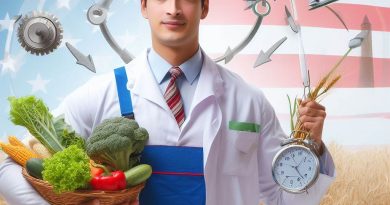Aquaculture in Agribusiness: Pros & Cons
Last Updated on March 2, 2024
Introduction to Aquaculture in Agribusiness
Aquaculture, a vital sector in agribusiness, involves cultivating aquatic organisms, contributing to our food supply.
Aquaculture refers to the breeding, rearing, and harvesting of aquatic creatures like fish, mollusks, and plants.
Aquaculture is crucial in agribusiness for several reasons, primarily helping to meet the growing global demand for seafood.
By practicing aquaculture, we reduce fishing pressure on wild fish stocks and protect biodiversity.
Aquaculture also contributes to food security and economic development, especially in coastal communities.
Through aquaculture, we can produce nutritious fish rich in omega-3s, ensuring a healthy diet for consumers.
Furthermore, this industry creates employment opportunities and generates revenue, benefiting local economies.
Aquaculture aids in reducing dependence on imports and helps maintain self-sufficiency in food production.
Moreover, it provides a sustainable alternative to overfishing and contributes to environmental conservation.
However, aquaculture also poses challenges like disease outbreaks, pollution, and negative impacts on ecosystems.
To overcome these cons, innovations in technology, farming practices, and regulation are necessary for sustainable aquaculture.
In fact, aquaculture plays a crucial role in agribusiness by providing sustainable seafood, creating employment, and ensuring food security.
By understanding its definition and significance, we can better appreciate the benefits and challenges of aquaculture.
Read: Climate-Smart Crops for Diversification
Pros of Aquaculture in Agribusiness
Aquaculture, also known as fish farming, has become an increasingly important sector in agribusiness.
This method involves the cultivation of aquatic organisms such as fish, shellfish, and plants in controlled environments like ponds, tanks, or cages.
Aquaculture offers several advantages that contribute to the growth and sustainability of agribusiness.
Increased production of seafood
One of the significant pros of aquaculture in agribusiness is the increased production of seafood.
Traditional fishing methods have limits in meeting the global demand for fish, but aquaculture can provide a consistent and predictable supply of seafood.
With fish farming, farmers can produce a large quantity of fish in a controlled setting, ensuring a more stable food source.
Reduced pressure on wild fish populations
Moreover, aquaculture helps reduce the pressure on wild fish populations.
Overfishing and destructive fishing practices have led to a decline in wild fish stocks.
By cultivating fish and other seafood, aquaculture reduces the reliance on capturing fish from the wild, thus allowing wild populations to recover and maintain their ecological balance.
Creation of employment opportunities
Aquaculture also creates employment opportunities.
Apart from fish farmers, this industry requires personnel for various tasks such as feed production, farm management, and processing.
As aquaculture operations expand, more jobs are generated, contributing to rural and coastal economic development.
Diversification of farming activities
Furthermore, aquaculture allows for the diversification of farming activities.
Farmers who traditionally engaged in livestock or crop production can now add fish farming to their operations.
This diversification minimizes the risks associated with relying on a single agricultural activity, ensuring a more stable income for farmers.
Potential for high profitability
Another advantage of aquaculture is its potential for high profitability.
Fish farming has a relatively short production cycle compared to other livestock production systems.
This faster turnover allows farmers to generate multiple harvests within a year and potentially increase their profitability.
Enhanced food security
Aquaculture also enhances food security.
As the world population continues to grow, ensuring a stable and sufficient food supply becomes crucial.
Fish, being a valuable source of protein and essential nutrients, play a significant role in addressing malnutrition.
Aquaculture helps meet the increasing demand for fish and contributes to global food security.
In short, aquaculture offers numerous benefits for agribusiness.
It increases the production of seafood, reduces pressure on wild fish populations, and creates employment opportunities.
Additionally, it diversifies farming activities, has the potential for high profitability, and enhances food security.
However, it’s worth noting that aquaculture also presents challenges such as environmental impacts, disease control, and feed sustainability, which must be addressed for long-term sustainability and responsible farming practices.
Read: Agri-Tourism: A Growing Income Source
Cons of Aquaculture in Agribusiness
There are several drawbacks associated with aquaculture in agribusiness.
These include:
- Environmental concerns (water pollution, disease spread): Aquaculture can lead to water pollution due to excessive fish waste and the use of antibiotics and chemicals. Disease outbreaks can also occur and spread easily in confined areas.
- Potential negative impact on local ecosystems: Introducing large numbers of farmed fish into natural habitats can disrupt the balance of local ecosystems, threatening native species and altering the food chain.
- Dependence on fishmeal and fish oils: Aquaculture often relies on fishmeal and fish oils made from small fish caught in the wild, putting additional pressure on global fish stocks and contributing to overfishing.
- Risk of introducing invasive species: The transfer of non-native fish species into new areas can have severe ecological consequences, as these species may outcompete or prey upon native species.
- Ethical concerns related to fish welfare: The intensification of aquaculture practices can result in overcrowded and stressful conditions for farmed fish, leading to poor welfare and suffering.
- Market challenges and competition: The aquaculture industry faces significant competition from other sources of protein, requiring continuous innovation and market adaptation to remain sustainable.
In general, while aquaculture in agribusiness offers many benefits, it is essential to address and overcome the various cons associated with this industry.
By implementing sustainable and ethical practices, and developing alternative feed sources, it is possible to mitigate these drawbacks and ensure the long-term viability of aquaculture in agribusiness.
Read: Data-Driven Farming: Key to Agri Success

Delve into the Subject: Exploring Farm Export Opportunities
Sustainable Aquaculture Practices
Aquaculture, also known as fish farming, has become an integral part of agribusiness.
While it provides various benefits, it also poses environmental challenges.
To ensure the long-term sustainability of aquaculture, it is crucial to implement certain practices.
Here are some sustainable aquaculture practices:
Implementing better waste management practices
- Regular monitoring and assessment of water quality to minimize pollution from aquaculture operations.
- Use of efficient filtration systems to remove excess waste and maintain water clarity.
- Implementing proper waste disposal techniques, such as recycling and composting, to prevent contamination of natural ecosystems.
Using sustainable feed alternatives
- Diversifying feed sources by incorporating plant-based ingredients and reducing dependence on fishmeal and fish oil.
- Promoting the use of novel feed additives, such as probiotics and enzymes, to optimize fish nutrition and minimize feed waste.
- Encouraging the development and utilization of alternative protein sources, such as insect meal and microbial biomass, for fish feed production.
Developing eco-friendly fish farming systems
- Designing and constructing closed-loop recirculating aquaculture systems (RAS) to minimize water usage and waste discharge.
- Integrating aquaculture with other agribusiness activities, such as agriculture or hydroponics, to utilize waste products for plant growth.
- Implementing innovative techniques, such as integrated multitrophic aquaculture (IMTA), to create symbiotic relationships between different species and enhance overall system productivity.
Conducting regular monitoring and assessment
- Regular monitoring of fish health and welfare to identify and address disease outbreaks or stress factors promptly.
- Monitoring of water quality parameters, such as temperature and dissolved oxygen levels, to ensure optimal conditions for fish growth and survival.
- Assessing the ecological impacts of aquaculture operations on surrounding ecosystems and implementing necessary mitigation measures.
Promoting responsible aquaculture guidelines and certifications
- Encouraging adherence to international and national standards, such as the Aquaculture Stewardship Council’s (ASC) responsible aquaculture principles.
- Supporting the development of eco-labeling and certification schemes to help consumers make informed choices.
- Collaborating with industry stakeholders, governments, and scientific communities to establish science-based regulations and guidelines for sustainable aquaculture practices.
By implementing these sustainable aquaculture practices, agribusinesses can minimize the negative environmental impacts while ensuring the production of high-quality seafood.
It is essential to strike a balance between production and conservation, fostering a resilient and sustainable aquaculture industry for future generations.
Read: Robotics in Farming: The Future of Agri-Tech
Conclusion
Aquaculture in agribusiness has both pros and cons.
The advantages include increased seafood supply, job creation, and reduced pressure on wild fish populations.
However, there are also environmental concerns such as pollution, disease outbreaks, and habitat destruction.
To ensure the long-term sustainability of aquaculture, it is crucial to implement and promote sustainable practices.
This includes proper waste management, use of renewable energy, and minimizing the use of antibiotics.
Furthermore, further research and technological advancements are needed to address the challenges and improve the efficiency of aquaculture.
This can involve developing better feed options, disease prevention techniques, and monitoring systems.
In a nutshell, while aquaculture offers promising opportunities for agribusiness, it is important to balance economic growth with environmental responsibility.
By adopting sustainable practices and investing in research and development, we can enhance the benefits of aquaculture while minimizing its negative impacts.


